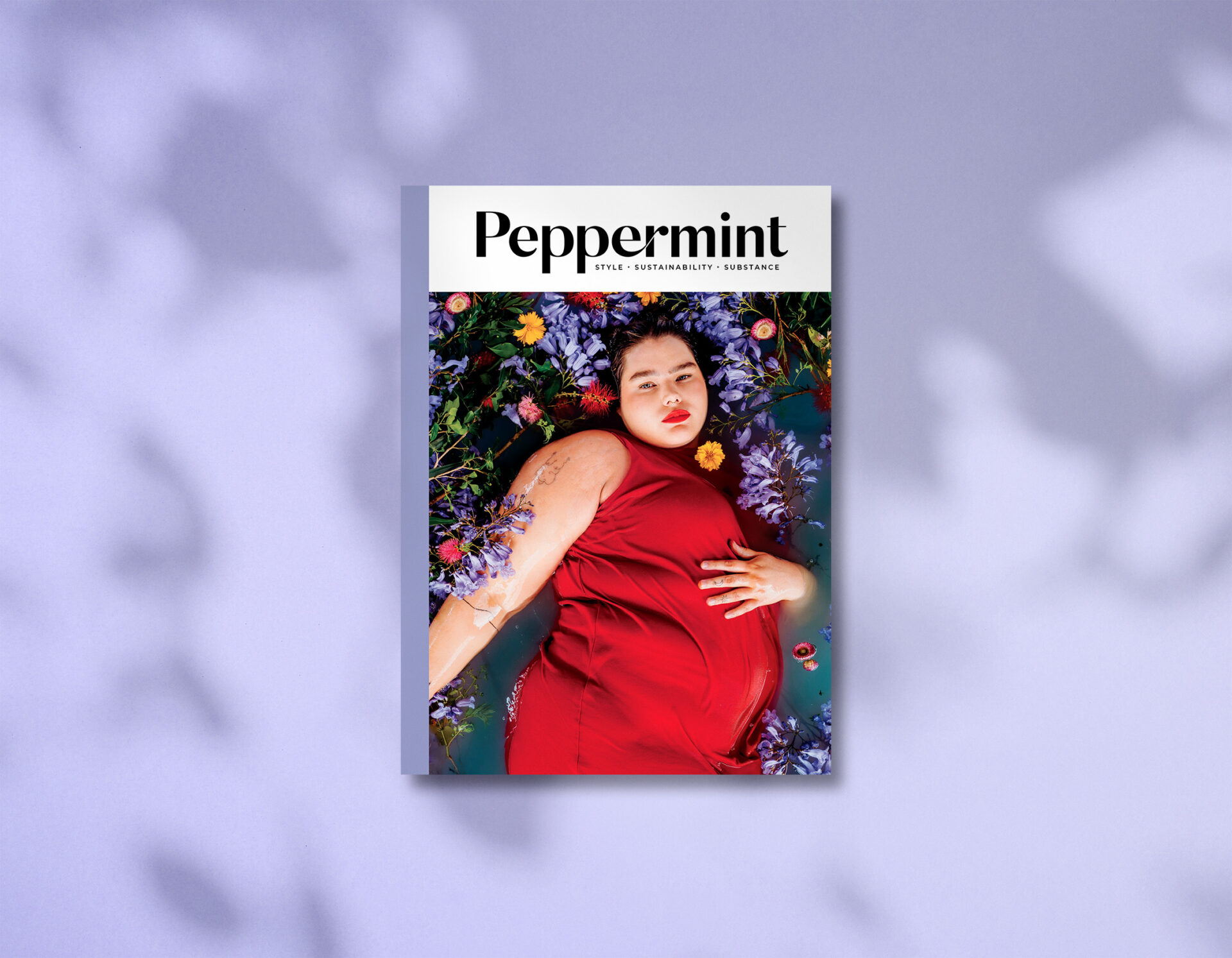
A Blooming Beauty – Our New Summer Issue Is Here!
Colour your world, dear reader, with our latest issue: blooming to life with stories aplenty to help add a dash of contemplation and creativity to your days.
We’re as chuffed as ever to release this issue into the world, packed with in-depth features, easy and fun DIYs and fresh takes on hot topics. It’s the perfect sidekick to a contented, cool summer. In this issue’s pages you’ll read about how we can use radical imagination to build a better world; why climate action is no longer a choice and the people and businesses leading the charge; activist Grace Forrest talks fighting slavery in the fashion industry, teaming up with photographer Liz Looker and stylist and San Cisco drummer Scarlett Stevens for an all-vintage photoshoot; soak in the lush blooming beauty of our vibrant floral cover; we go behind the seams of the heart and home of Little Tienda powerhouse Em Dezentje; meet the craftivists knitting truth to power; learn how to make peace with the food on your plate with three nutritionists; we put science communication under the microscope, exploring the challenges it faces fighting misinformation; meet the innovative duo making waves and addressing body acceptance with a one-size swimsuit; solidarity in sweatiness – we dive into why perspiration feels like the last femme taboo; the clever cookie behind Brisbane brand Alice Nightingale on biscuits and celebrating quirky Australiana; and we try period undies to see what the bloody deal is.
Plus you’ll find a tops pillowcase thrift flip DIY and a collection of solar-powered projects to harness Old Sol’s mighty energy; slip, slop, slap and slide your way into summer with a roundup of sun protective goodies; Quandamooka artist Delvene Cockatoo-Collins weaves connection and family stories from her island home; sowing seeds of change with Fairtrade cotton; find your soil mates (by the thousand) with worm composter The Worm Monger; we explore the beauty and life lessons of learning to sew with your mum; chase whales, dolphins and stunning sunsets on Queensland’s Minjerribah (Stradbroke Island); plus preserving and fermenting queen Kylee Newton shares a recipe from her latest preservers’ companion book!
And can we take a moment for that cover?! The gorgeous Tegan Lewis wears A.BCH while immersed in floating flowers by Lucy Reid of Foraged and Fleurs.
Get your copy to take from bed to beach this summer by visiting our shop or your closest stockist (and for the digital version, head here).
Take a peek inside this issue!
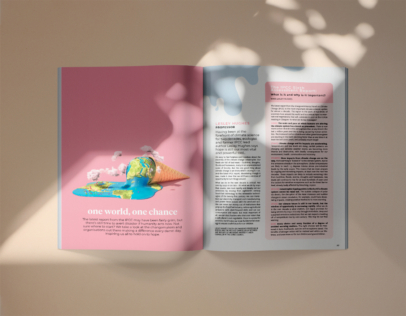
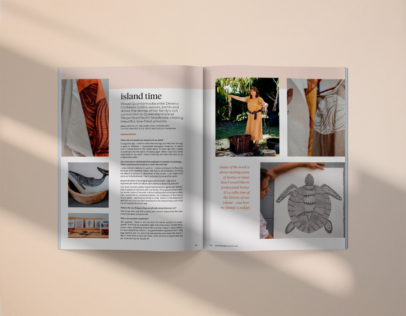
LEFT: ‘ONE WORLD, ONE CHANCE’ CLIMATE FEATURE, RIGHT: DELVENE COCKATOO-COLLINS
‘DON’T SWEAT IT’ Blood, no worries. Tears – sure! But for women, sweat is still a taboo spoken about with hushed tones and clenched armpits. Words by Helen Dewar.
Ahhh, summer. The time of year when the sun shines, the beach calls and my wardrobe does a whiplash-inducing 180 from cheery colours to a strictly monochrome look. Why? Because, dear reader, I’m a woman who just has to glance at a warm weather report to feel the onset of sweat beads on my forehead and damp patches under my arms. My ability to sweat when the going gets hot means my summer sartorial choices are entirely based on what’ll best hide the fact I’m risking dehydration just by existing – and for many years, I thought I was the only one.
You see, I grew up thinking women don’t sweat. I’d never see women sweating in adverts or TV shows or movies, unless I was watching something where the writers wanted us to know the female lead was a tomboy and – what a kook! – didn’t care how she looked! Even then, she was just sprayed with a light mist that made her look hot, somehow, rather than actually hot.
I also grew up hearing the saying, “Horses sweat, men perspire but ladies merely glow” – which only served to inform me, alarmingly, that I was a horse. This charming phrase is thought to have first appeared in an etiquette guide from the days of Queen Victoria – who, presumably, only ever broke into a light glow while single-handedly leading the British Empire for almost 64 years.
I also grew up hearing the saying, “Horses sweat, men perspire but ladies merely glow” – which only served to inform me, alarmingly, that I was a horse.
‘ONE WORLD, ONE CHANCE’ The latest report from the IPCC may have been fairly grim, but there’s still time to avert disaster if humanity acts now. Not sure where to start? We take a look at the changemakers and organisations out there making a difference every damn day, inspiring us all to hold on to hope.
“It’s easy to feel helpless and hopeless about the enormity of the climate change catastrophe. Our feeds are full of bad news – bushfires, droughts, floods and heatwaves, many on an unprecedented scale of ferocity. But the one good thing about climate change is we know what’s causing it – us. And the latest IPCC report, devastating though it was, made it clear that we still have a window of opportunity to turn things around.
What we do in the next decade is critical. Net zero by 2050 is too late – it’s what we do by 2030 that counts. We must rapidly and deeply cut our emissions by moving from eighteenth century fossil-fuel technology to the renewable technologies of the twenty-first century. We can transition our electricity, transport and manufacturing, and power these sectors with the wind and sun. We can move our money out of institutions that prop up the fossil fuel industry, reduce agricultural emissions with plant-focused diets and cut our consumption and waste. But most important of all, we can elect leaders who share our vision that a safe planet is not negotiable. Hope is a powerful emotion, but it’s also our most fundamental strategy to ensure a safe future for our children.”
– Lesley Hughes, climate scientist and academic
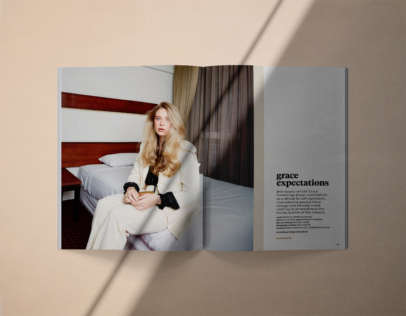
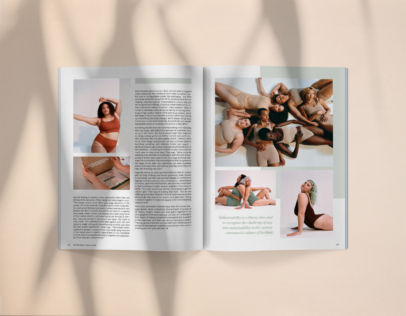
LEFT: GRACE FORREST, RIGHT: SUSTAINABLE SWIMWEAR BRAND YOUSWIM
‘GRACE EXPECTATIONS’ Anti-slavery activist Grace Forrest has always used fashion as a vehicle for self-expression, championing second-hand, vintage and ethically made clothing as an antidote to the murky realities of the industry. Words by Rebecca Jamieson Dwyer
An outspoken anti-slavery activist, Grace founded Walk Free in 2011 – an international human rights organisation focused on accelerating the end of modern slavery in all its forms – and is the current WA Young Australian of the Year, as well as the UN Association of Australia’s youngest ever Goodwill Ambassador. Walk Free publishes the Global Slavery Index, the world’s leading data set on modern slavery and what governments are doing to tackle it, and was instrumental in the Australian Parliament passing the Modern Slavery Act in 2018, which requires all companies with revenue of more than $100 million to report on modern slavery in their supply chains. Grace was already campaigning against the conditions in which so many garment workers around the world work and live when tragedy struck in 2013 with the collapse of the Rana Plaza factory in Bangladesh, which killed more than 1100 workers.
But Grace says this event forced many to look at their wardrobe and buying habits in a whole new light. “The scenes of bodies being pulled out of the rubble of a collapsed building showed just how ruthlessly the fashion industry valued profit over people,” she says. “Seeing and learning about this as a young person radically changed my relationship with fashion. Something I had once loved as an expression of identity, fun and joy now riddled me with anxiety and rage. How could more people not know about this? Or worse still, how could more people not care?”
‘UNDER THE MICROSCOPE’ Science communication is incredibly powerful. But as we’ve seen in the climate space and most recently through the pandemic, when mis- and disinformation are weaponised, it can prove to be dangerous. Words by Lauren Baxter
In a social landscape that has only become more fractured over time – as our attention spans and comprehension of the big issues are eroded by platform after platform – science is seemingly less accessible than ever. The last two years have exposed just how much of the population is vulnerable to misinformation. It travels faster and further than the truth. And it’s often a problem of science communication.
When it comes to science as a broad discipline, however, most research over the last 30 years suggests that people are very supportive. “I think in Australia, at least, we’ve got a pretty good level of trust about science,” Dr Linden Ashcroft, lecturer, climate scientist and science communicator at the University of Melbourne, says. “Scientists are seen as good guys. They are seen as contributors and beneficial, positive members of society. But what I see in people lately is a distrust of something that’s new, or a distrust in a change in the scientific process.”
More and more we are seeing public discourse about scientific issues driven by those who are not only unqualified to comment, they are unfamiliar with the consequences of their commentary. As the 24-hour news cycle ticks along, every man and his dog becomes an expert in everything from epidemiology to the war in Afghanistan. In these fragmented times, we run the risk of consuming too much information and worse, information that is vague, ripped out of context and unfalsifiable. Couple this with the fact there is a small but very loud minority seemingly immune to facts who are weaponising disinformation, and you begin to uncover the breadth of the problem.
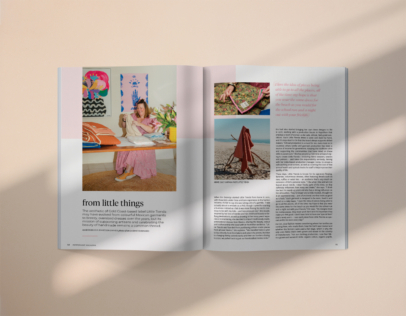
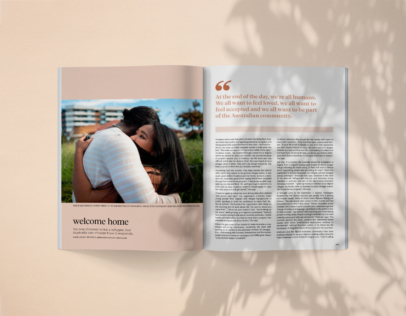
LEFT: ETHICAL FASHION LABEL LITTLE TIENDA, RIGHT: ‘WELCOME HOME’
‘FROM LITTLE THINGS’ The aesthetic of Gold Coast-based label Little Tienda may have evolved from colourful Mexican garments to breezy, oversized dresses over the years, but its mission of supporting artisans and celebrating the beauty of handmade remains a common thread. Words by Rebecca Jamieson Dwyer.
When Em Dezentje started Little Tienda from home in 2012, with three kids under three and zero experience in the fashion industry, it’s fair to say she was taking a bit of a gamble. “I was actually about to embark on a PhD, though I opted for starting a business instead as I felt it was more freeing for me to continue to be with my kids – and less pressure too,” she recalls.
Inspired by her love of textiles and her childhood travels to far-flung destinations, as well as drawing on her many years’ experience in marketing, she decided to import traditionally made, embroidered dresses from Mexico, sharing the beauty, colour and craftsmanship she loved with an Australian audience. “Little Tienda was founded from purchasing artisan-made pieces from all over Mexico,” she explains. “We travelled twice a year to buy directly from the makers and select the pieces, but due to changing family commitments and then our borders closing in 2020, we pulled back to just our handcrafted merino knits.”
Em had also started bringing her own dress designs to life in 2017, working with a production house in Rajasthan that employs a team of women under safe, ethical, fairly paid conditions. Each Little Tienda dress is sewn and dyed by hand, and it’s important to Em that the brand always supports skilled makers: “Ethical production is a must for me, even more so in countries where textile and garment production has been a source of income for generations. Keeping the traditions alive and supporting the communities that have relied on these skills is paramount.” She has around 50 full-time artisans helping to create Little Tienda – including fabric weavers, sewists and printers – and takes the responsibility seriously, liaising with her India-based production manager, Sonia, to ensure a safe working environment, as well as covering the cost of free annual health and optical checks for staff to help improve their quality of life.
Ethical production is a must for me, even more so in countries where textile and garment production has been a source of income for generations. Keeping the traditions alive and supporting the communities that have relied on these skills is paramount.
‘SUN WORSHIP’ Teaching traditional skills and living a permaculture life, Anna Matilda from The Urban Nanna shows us how to harness solar power for some fun in the sun.
While the days of worshipping the sun by slathering on coconut oil and sunbaking for hours on end are a thing of the past, there are many other ways to use Old Sol’s mighty energy for fun and exciting DIY projects. From making your own tea, seasonings and body products to whipping up baked goods in an unusual way and even creating a wearable version of the sun, it’s time to get excited for summer and all the clever, crafty things you can make and do on days when the rays are out in force.
Make hay while the sun shines
Catching and storing the sun’s energy in dried herbs, fruits, veg and flowers is a brilliant way to make the most of seasonal abundance so you can enjoy it all year round. Use summer’s hot, sunny days to dry your harvest, and then store it in airtight jars until needed.
Hang herb bunches in sunny locations – such as a clothesline, a north-facing window or even the rearview mirror of a car – during the day. Dry flowers or fruit and veg slices by laying them out flat on a basket, cake rack or clean fly screen and placing it somewhere hot, dry and sunny – a brick courtyard or concrete driveway is perfect.
‘FAMILY MATTERS’ A timeless skill passed down through the generations, sewing so often becomes the thread that stitches families together. Words by Bonnie Liston.
My mother, Janet, was taught to sew by her mother, Judith, who was taught to sew by her mother, Amy, and so on throughout time, possibly back to the Mitochondrial Mother of Sewing herself.
At many of the pivotal events in my mother’s early life, whether as a baby being christened, a young debutante or a blushing bridesmaid, she was wearing a gown made for her by her mother. Young Janet was also a keen sewist, but she drifted out of the habit – her last big project was a quilt intended to celebrate my sister’s birth, found uncompleted many years later with the pins rusted in place. It seems the reality of having three children under five left no time for the noisy, sharp needle machine.
In learning to sew, I unlocked a whole new language I could use to communicate with my mother and her mother.
‘WELCOME HOME’ No one chooses to be a refugee, but Australia can choose how it responds… Words by Linsey Rendell.
All humans are equal – whether they are on local soil or far away. According to the Australian Human Rights Commission, “Australia has obligations to protect the human rights of all asylum seekers and refugees who arrive in Australia, regardless of how or where they arrive and whether they arrive with or without a visa.” At this moment, Australia could choose to have a less negative impact on people’s lives, to end mandatory detention and to support safe passages for people to heal and flourish.
Despite the federal approach, across Australia, 166 local government areas have become self-declared Refugee Welcome Zones, and individuals and groups are volunteering to support refugees as they settle in Australia through community sponsorship. “Community groups across the country are ready to play their part. We just need the government to say yes,” Shabnam Safa says.
Looking ahead, transformation of Australia’s immigration policies and language needs to be refugee-led.


